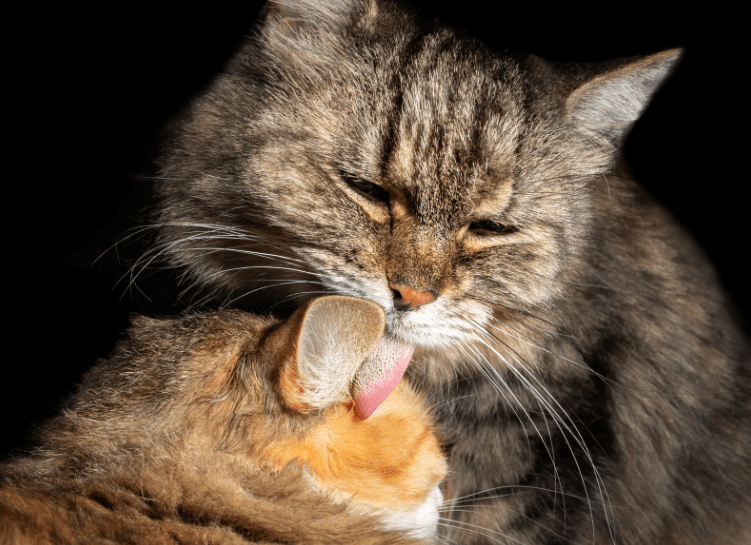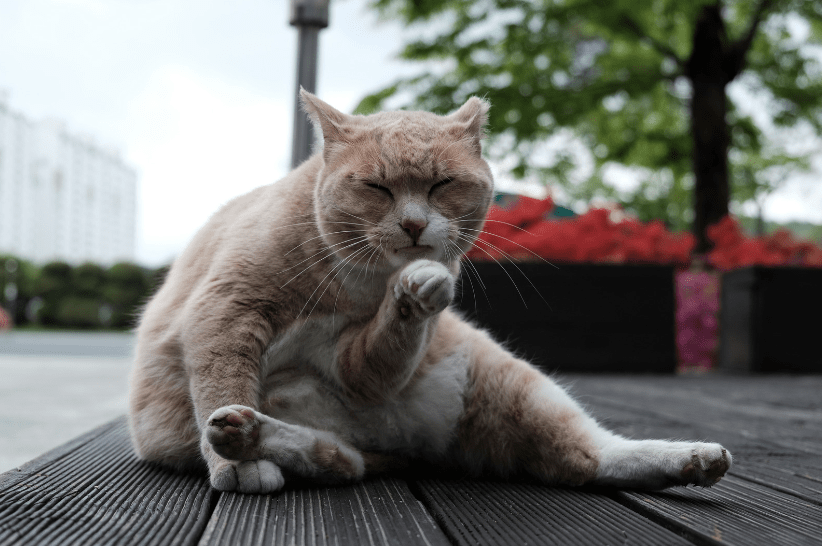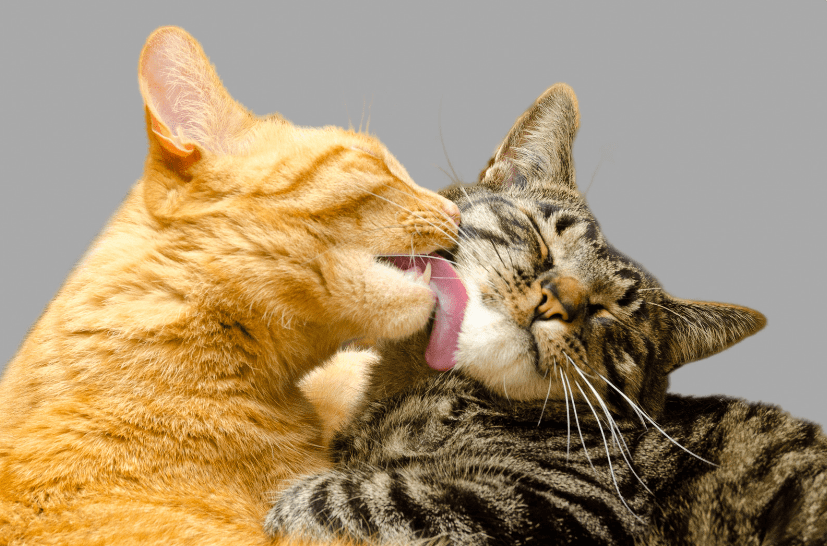Cats groom each other to reinforce social bonds but may fight due to overstimulation or boundary setting. This grooming, followed by fighting, reflects complex feline social dynamics.
Understanding the curious behavior of cats can be quite fascinating. Cats often engage in mutual
grooming, known as allogrooming, which usually serves as a sign of affection and social connection between feline companions. Yet, moments later, this peaceful interaction can escalate into a skirmish.
This abrupt shift from grooming to fighting might seem puzzling, but it’s not uncommon in the world of cats. Grooming maintains their social hierarchy and helps them bond. However, cats have sensitive spots and a low threshold for irritation. If one cat grooms too vigorously or in a sensitive area, the other might react aggressively. Such an interaction is a testament to the nuanced communication and behavior of our feline friends, revealing their complex emotional and social lives. Understanding this behavior can help cat owners distinguish between normal social conduct and problematic aggression, fostering a harmonious environment for their pets.
Feline Social Behaviors: Affection Or Aggression?
Cats baffle us with their social antics. One moment they’re licking each other softly. The next, hisses and swipes fill the air. This complex dance between affection and aggression paints a mysterious picture of feline social behaviors. Are these furry creatures expressing love or declaring battle?
The Complexities Of Cat Interactions
Cat behaviors are varied and nuanced. They share a sophisticated social structure. Sometimes they purr and nuzzle to bond. Other times, they smack and chase as control play. Grooming can swiftly shift from a sign of trust to dominance. This duality is normal in the feline world. It’s how cats set boundaries and form hierarchies within their social groups.
Decoding Signals: When Grooming Meets Fighting
Understanding cats’ unique language is key. Grooming, or ‘allogrooming,’ often starts as an affectionate act. It’s a way to show care and build a familial bond. But watch closely. A nip or a claw could slip out if a cat feels its space gets invaded or its patience runs thin. The swift shift from licks to flicks is a message. It’s a cat’s way of saying, “I’ve had enough.”
- Grooming serves multiple purposes:
- Cleaning hard-to-reach areas
- Strengthening social bonds
- Displaying trust and affection
- Fighting can arise from:
- Over-excitement or overstimulation
- Miscommunication among cats
- Boundary setting and hierarchy establishment

The Science Behind Allogrooming In Cats
Ever noticed cats licking each other, and then suddenly starting a fight? This curious behavior is part of their social dynamics. Behind every lick and nibble lies a complex world of feline communication. Let’s explore the fascinating science of allogrooming in our feline friends.
Allogrooming: More Than Just Cleaning
Cats groom each other for reasons beyond cleanliness. Scientists call this behavior
allogrooming. It’s not merely about hygiene. Cats use allogrooming to strengthen social bonds. It’s a ritual that serves multiple purposes in their intricate social structures.
- Stress Reduction: Allogrooming can help to reduce anxiety and calm nerves.
- Scent Sharing: It blends its scents, fostering a unified group odor.
- Hard-to-Reach Areas: Cats help groom spots that are challenging to reach on their own.
Sometimes grooming leads to overstimulation or irritation, which can cause a friendly session to escalate into a skirmish.
Bonding Rituals And Hierarchies In Feline Groups
In the feline world,
allogrooming is a pivotal bonding ritual. It’s also a way to establish and reinforce hierarchies within a group. Typically, the dominant cat gets groomed by the others, affirming its status at the top.
Cats who share a close bond often partake in mutual grooming, which is known as social grooming. This act serves to maintain peace and shows acceptance and trust among them.
| Behavior |
Meaning |
| Grooming Head and Neck |
Social Bonding |
| Grooming then Fighting |
Play or Overstimulation |
| One-Sided Grooming |
Display of Dominance |
Although grooming is a sign of affection,
it can turn into play or assert dominance. Playful nips during grooming sessions can be misinterpreted, leading to a swift change in mood and a potential tussle.
Understanding these behaviors can help cat owners recognize the underlying reasons for fights after grooming. Always monitor your pets to ensure their play remains friendly and to intervene if tensions rise.
The Sudden Shift: From Grooming To Brawling
The Sudden Shift: From Grooming to Brawling
At first glance, the sight of two cats grooming each other seems like the utmost expression of feline affection. This peaceful, soothing behavior, known as allogrooming, embodies the social bond shared between cats. Nevertheless, this harmony can rapidly turn into a full-blown fight. One might wonder why such tender moments so often end with claws out and fur flying.
Trigger Points: Recognizing Signs Of Agitation
- Flattened ears
- Twitching tails
- Dilated pupils
- Low growls
These subtle cues hint at a build-up of tension. They indicate that one cat may have had enough of the social interaction. It’s crucial to note these signs as they are a cat’s way of communicating discomfort. Ignoring them could lead to a misunderstanding, sparking a sudden squabble.
Understanding Boundaries In Feline Social Dynamics
Cats are creatures that respect personal space and boundaries. When grooming, one cat might accidentally bite too hard or lick a sensitive spot. The other cat, feeling its space invaded, reacts to defend itself. Recognizing and respecting personal limits is key in maintaining a peaceful relationship between feline friends. Ensuring they each have their own safe space can help prevent these grooming sessions from turning into unwanted wrestling matches.
Territorial Tensions And Playful Scuffles
Cats often show affection and establish social bonds through grooming. But sometimes, this peaceful grooming can suddenly shift to a skirmish. This behavior might confuse onlookers, as what starts as a friendly interaction turns into a hiss and paw-swat dance.
Understanding the fine line between a cat’s territorial instincts and their play tendencies is key to interpreting these interactions.
Marking Territory: How Grooming Plays A Role
Grooming isn’t just about cleanliness; it’s about
communication and territory. When cats groom each other, they are also
spreading their scent. This shared scent marks them as members of the same group, creating a collective territorial boundary.
- Cats have scent glands on their faces and bodies.
- Grooming distributes these scents to mark group territory.
- Scent sharing reinforces social bonds but also marks ownership.
Differentiating Play From Real Aggression
Distinguishing between play-fighting and true aggression is important.
Playful scuffles involve softer, inhibited bites and claws retracted. It’s a form of exercise and social interaction.
| Play |
Aggression |
| Rounded, open claws |
Sharp, extended claws |
| Soft bites, no skin breaks |
Intense bites, potential injuries |
| Relaxed body language |
Stiff, poised to attack stance |
Recognize signs of play:
chasing, pouncing, and relaxed ears. True aggression features:
flattened ears, growling, and
focused, unblinking stares. If grooming shifts to aggression, separate the cats calmly.

Communication Cues: Unseen Signals At Play
Cats communicate in ways humans often miss. These signals explain moments of peace followed by sudden skirmishes. Owners may wonder why cats groom each other, and then fight. Understanding cats means delving into their silent language of scent and body movements.
The Role Of Scent And Touch In Feline Communication
Grooming serves multiple purposes for cats, beyond just cleanliness. It’s a
social activity that bonds them together. They exchange scents, crucial for their interactions. Through grooming, cats mix their smells to create a colony scent. This signals
unity and familiarity among them.
Scent glands on their bodies leave behind unique identifiers. When two cats are grooming, they are
exchanging these personal scents. It lays a foundation for their relationship and communication.
- Head bumps transfer scents from facial glands.
- Licking spreads scents and shows trust.
- Touch with paws can be a positive signal.
Sudden biting during grooming may be a sign of overstimulation or miscommunication. A cat’s sensitive nose might detect a strange scent on its companion, prompting a fight.
Reading Body Language: Subtle Signs Before A Fight
Observing body language
tells us much about a cat’s feelings. Before a fight, there are often subtle signs:
- A twitching tail indicates irritation.
- Flattened ears show annoyance or aggression.
- Dilated pupils suggest heightened emotion.
Battles break out not always from hostility but from these signals being ignored or misinterpreted. Cats have different tolerance levels. What starts as a friendly gesture might cross into personal space and cause discomfort. As an owner, spotting these
early signals can prevent the scuffles often seen after grooming.
Multi-cat Households: The Peaceful Coexistence Challenge
Multi-Cat Households: The Peaceful Coexistence Challenge often brings a unique mix of charm and chaos. Cats, known for their independent nature, sometimes form complex social hierarchies. When multiple felines share a space, understanding their interactions becomes key. Picture two cats grooming one another – a sign of affection, right? But then, unexpectedly, they burst into a tiff. This behavior puzzles many cat owners and raises questions about harmony in multi-cat homes.
Managing Multiple Cats And Their Social Interactions
Managing a household with more than one cat requires insight into feline behavior. Cats exhibit a range of interactions, from grooming to fighting, often in quick succession. Grooming is a social activity that can reinforce cat bonds. However, it can also turn into a fight if one cat becomes too rough or crosses personal boundaries.
Observation is crucial. Watch for signs of tension, such as hissing or swatting, even during peaceful grooming. Ensure each cat has their own space for alone time, such as separate beds or perches.
Set up Resources Strategically. Provide multiple food bowls, litter boxes, and scratching posts. This reduces competition and the need for cats to cross territories.
Strategies To Reduce Conflict And Encourage Harmony
Conflict reduction in multi-cat households hinges on recognizing each cat’s needs and creating an environment that caters to them. Here are strategies to promote harmony:
- Feed Separately: Prevent food aggression by giving cats their meals in different areas.
- Introduce Slowly: When bringing a new cat home, introduce them gradually to prevent territorial disputes.
- Use Pheromones: Synthetic pheromones can help calm cats and make cohabitation smoother.
Remember, playtime is key. Engage your cats in play to prevent boredom and reduce tension. Use toys that encourage individual play as well as group interaction.
The Role Of Humans In Cat Socialization
Have you ever watched your furry friends groom each other and then, out of nowhere, a playful scuffle breaks out? This quirky behavior is rooted in their social patterns. Humans play a big part in shaping these patterns. Let’s explore the human effect on feline friendships.
How Human Interaction Impacts Feline Behavior
Your touch and voice can calm the waves in the sea of cat emotions. Cats learn to trust and socialize through your actions and vibes.
- Pets and cuddles can ease a cat’s stress.
- “Meow-talk” teaches cats to “chat back” and bond with you.
- Playing fetch or chase strengthens their social skills.
Interacting with many people teaches kittens that humans are friends. It’s best to start when cats are young, as kittens soak up experiences like sponges.
Creating A Safe And Stimulating Environment For Cats
A cat’s environment is their kingdom. A well-set realm can inspire joy and peace among your paw pals. Here’s what sets the royal standard:
| Element |
Action |
Benefit |
| Nooks and Trees |
Provide hiding spots and high perches |
Refuge and lookout spots breed comfort |
| Interactive Toys |
Offer toys that mimic prey behavior |
Feeds their hunter instinct without upset |
| Scratching Posts |
Place in communal areas |
Allows stress relief and territorial marking |
Regular playtime and a clean, enriching environment cut down on cat tiffs. Each cat needs their own food bowl, water source, and litter box. Also, regular vet visits ensure a fight-free fur family.
Remain patient and consistent. Cats sense routines and stability, bringing peace to their interactions. Your gentle guidance and safe spaces lead to harmony at home. Happy cats, fewer scuffles.

Health Implications Of Grooming And Fighting
Understanding
why cats groom each other and then fight is key to ensuring their well-being. These behaviors can have deep-rooted health implications. It is essential to be aware of these signs.
When Grooming Indicates Underlying Health Issues
Cats groom each other as an act of social bonding. But sometimes, what seems affectionate might signal health problems. Changes in grooming habits can reveal hidden issues.
- Excessive grooming might point to skin conditions or stress.
- Grooming in new areas may indicate pain or discomfort nearby.
- A lack of grooming could mean your cat isn’t feeling well.
Stay observant and consult with a vet if you notice unusual grooming behaviors.
The Risks Of Injuries From Cat Fights
Fighting, although a normal part of cat interaction, carries risks. Scratches and bites can lead to infections or more serious complications.
| Injury |
Risks |
Preventive Actions |
| Scratches |
Potential for abscesses |
Regular nail trimming |
| Bites |
Risk of bacterial infections |
Monitoring play sessions |
| Deep wounds |
Possibility of long-term health issues |
Immediate veterinary care |
Prevent fights when possible and address any injuries promptly to safeguard your cat’s health.
Enhancing Feline Welfare Through Understanding
Cats are complex creatures. Their behaviors often puzzle owners. Grooming then fighting seems contradictory. Understanding this can improve cat welfare. Let’s explore feline behavior.
Education On Feline Behavior For Cat Owners
Knowing why cats groom each other is key.
- Allogrooming is the technical term for cats grooming each other.
- It’s a social activity, showing trust and companionship.
- Sometimes, it can turn into a fight.
- This might happen if one cat becomes overstimulated or annoyed.
Recognizing
body language can prevent conflicts. Look for:
| Positive Signs |
Warning Signs |
| Soft purring |
Flattened ears |
| Gentle head bunts |
Hissing |
| Relaxed posture |
Swishing tail |
Professional Insights: When To Seek Help
Cats may need a professional’s touch.
- Excessive fighting after grooming is a red flag.
- Injuries from fights mean it’s time to act.
- Persistent stress in one or both cats can lead to health issues.
Consult a
veterinarian or
animal behaviorist if:
- You notice changes in eating habits.
- Your cat shows aggression towards humans.
- There’s continuous hiding or avoidance behavior.
Educating yourself on feline Affective aggression can enhance cat welfare. Act early to keep your furry friends
happy and healthy.
Conclusion
Exploring the quirks of cat behavior can be fascinating and perplexing. Cats groom and then spar for complex reasons rooted in their social and instinctive behaviors. It’s not just a pastime; it’s a blend of affection, hierarchy, and instinct. Observing these feline rituals offers a glimpse into their enigmatic world, where love and rivalry often intertwine.
So, watch and learn – your cat’s actions are a window into their soul.







